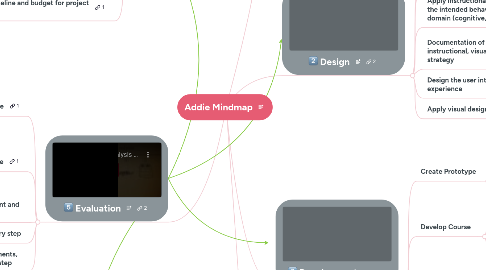
1. Analysis
1.1. Who is the audience and their characteristics?
1.1.1. Age, gender, socioeconomic status, experience, education; all of those inform the way the learning materials have to be presented to achieve maximum learning efficiency.
1.2. Identify the behavioral outcome of the learning.
1.2.1. The goals must be described in detail from the outset, and they must be measurable.
1.2.2. Analysis can help you is by enabling you to discover early that skills you aim to impart in your course are ill-suited for eLearning and require live courses with workshops.
1.3. What types of learning constraints exist?
1.3.1. Will the rules of the organization affect the ability to offer the content
1.3.2. Are there limitations on the length of the learning?
1.3.3. Does the setting meet the requirements? Will the setting impact effectiveness?
1.3.4. Rights to content or copyright concerns.
1.4. What are the delivery options?
1.4.1. In Person
1.4.2. Blended
1.4.3. Online
1.5. What is the timeline and budget for project completion?
2. Implementation
2.1. Develop procedures for release
2.1.1. Train instructors/Facilitators
2.1.2. Prepare learners for the information they will receive and the process to follow.
2.1.3. Prepare the environment
2.2. Check/Install technology needed
2.2.1. Ensure learners have access to register or participate.
2.2.2. Ensure learners have a resource to connect in the event the training is not held or available.
2.3. Receive Feedback
2.3.1. Participate in-person to see the content flow.
2.3.2. Survey groups of learners on the process and content.
2.4. Check content against education goals.
2.5. Pilot a new process or new content with a select group of learners.
3. Evaluation
3.1. Formative
3.1.1. One on one
3.1.2. Small group,
3.1.3. Field Trial
3.2. Summative
3.2.1. Kirkpatricks Level 1
3.2.2. Level 2
3.2.3. Level 3
3.2.4. Level 4
3.3. Determine needs to maintain content and ensure access to learners
3.4. Feedback at every step
3.5. Evaluate the cost, schedule, requirements, and risk. Decide Go-No Go at every step
4. Design
4.1. Evaluate costs and effort required
4.2. Create storyboards
4.3. Apply instructional strategies according to the intended behavioral outcomes by domain (cognitive, affective, psychomotor)
4.3.1. Assessment instruments
4.3.2. Exercises used for learning and recall
4.3.3. Media selection
4.4. Documentation of the project’s instructional, visual and technical design strategy
4.5. Design the user interface and user experience
4.6. Apply visual design
5. Development
5.1. Create Prototype
5.1.1. Get approval and feedback from administration.
5.2. Develop Course
5.2.1. Add illustrations and media to ensure it is engaging.
5.2.2. Ensure information is presented in logical order.
5.2.3. Continue to review education goals of the course.
5.2.4. Quality Assurance - when a module is complete have it evaluated by fresh eyes for feedback.
5.3. Conduct Test Run
5.3.1. Measure the time it takes to complete.
5.3.2. Measure the actual learning against the goals.
5.3.3. Submit for final review of administration.

